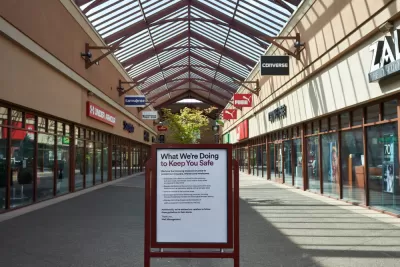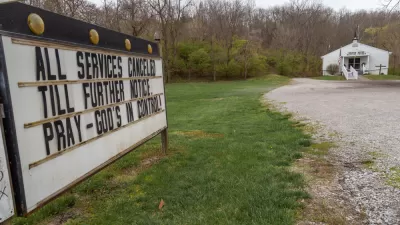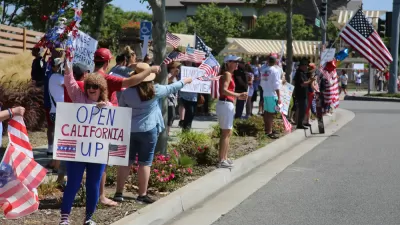These two Western states did something that none of the 20 other states in the nation going the wrong way in the pandemic have yet to do: they paused their reopening plans due to rising coronavirus infections and hospitalizations.

Last month, The Atlantic science writer, Ed Yong, described the coronavirus outbreak in the U.S. as a "patchwork pandemic."
This pattern exists because different states have experienced the coronavirus pandemic in very different ways. In the most severely pummeled places, like New York and New Jersey, COVID-19 is waning. In Texas and North Carolina, it is still taking off. In Oregon and South Carolina, it is holding steady.
Furthermore, in the absence of federal leadership, the patchwork is essentially a 50-state experiment, with governors "freelancing", as Scott Greer, a political scientist at the University of Michigan School of Public Health, told NPR on April 17. "You just have to have somebody who can give authoritative guidance, who can give governors cover for taking risky actions, who can deploy federal resources," he said. He was referencing the role of Ron Klain, President Obama's "Ebola czar" in 2014.
Second inning?
On April 22, University of Minnesota infectious disease expert, Michael T. Osterholm, told CNN that the U.S. was "only in the second inning of a nine-inning contest, with the possibility of as many as 800,000 deaths or more in the US over the next 18 months."
In the first inning, Governors like California's Gavin Newsom, a Democrat, and Ohio's Mike DeWine, a Republican, were widely praised for the action they took in mid-March in enacting social distancing restrictions and ultimately issuing stay-at-home orders (on March 19 and March 22, respectively). New York Gov. Andrew Cuomo (D), the second governor to shut down his state's economy, came to be called America's governor due to his widely covered press briefings. Now, in early June, the experiments continue as all fifty states, the District of Columbia, and Puerto Rico undergo their reopenings, guided by their governors and state health departments.
Marching forward despite contagion
The United States has "quarantine fatigue," wrote POLITICO health care reporters Alice Ollstein and Dan Goldberg on June 10. "The coronavirus is spiking in more than a dozen states and intensive care beds are filling again, but several governors have no plans to reimpose shutdown measures or pause reopenings, a sign that the political will to take drastic measures has dissipated even as the virus is still raging."
The New York Times U.S. coronavirus tracker on June 14 shows that for the last two weeks, cases have:
- Increased in 22 states and Puerto Rico in the last two weeks;
- Stayed the same in nine states and Guam
- Decreased in 19 states and Washington, D.C.
- Total U.S. cases exceed 2.08 million and deaths exceed 115,000, amounting to about 27% for each indicator despite the U.S. having only 4.25% of the world's population.
The first state to pause
"Just one state, Utah, has paused the next phase in its reopening plan amid a two-week spike in new case," observed Ollstein and Goldberg on Wednesday. There's some irony there as the Beehive State was one of only eight states that never fully shut down.
Gary Herbert of Utah, the lone governor to slow down his state’s reopening amid surging infections, went against the advice of a state commission by extending current restrictions for at least another week.
"We all want to return to more normal patterns of life as soon as possible, but we also do not want to take a step back in our progress against this disease and our reactivation of the economy," said Herbert in the June 5 press release announcing the 1-week pause in turning the color-coded "risk dial" toward the green "new normal."
"A marked increase in disease incidence and in hospitalizations due to COVID-19 give us pause. We will continue to analyze data trends with an eye toward balancing overall health risks and protecting high risk populations..."
On June 12, Herbert issued an executive order that moved one of the state's 29 counties, Kane, to the final green reopening phase. The order also moved two of the remaining 28 counties to the "Low Health Risk Status, or Yellow" phase. However, Salt Lake City will remain in the "Moderate-Risk (Orange) Phase." Well over half of the state's COVID-19 cases, hospitalizations and deaths are in Salt Lake County, although only Salt Lake City will remain in the orange phase.

Oregon "presses pause" for one week
"Oregon’s Democratic Gov. Kate Brown announced Thursday night she would pause reopening plans for at least one week after the number of daily new infections nearly doubled in the past week," report Ollstein, Goldberg and Rachel Roubein in a follow-up article in POLITICO on June 12 (source article).
“When we began reopening nearly a month ago, I was clear that COVID-19 case counts would rise," said Brown in a press release. "We now see that happening in several parts of the state, both urban areas and rural communities."
"As I have said before, reopening comes with real risk. As we navigate the reopening, we are carefully monitoring the capacity of our public health system to respond to COVID-19 cases without becoming overwhelmed.
“The noticeable increase in COVID-19 infections in Oregon over the past week is cause for concern.
“In order to ensure that the virus is not spreading too quickly, I am putting all county applications for further reopening on hold for seven days. This is essentially a statewide 'yellow light.' It is time to press pause for one week before any further reopening."
Portland setback
"Multnomah County is the only county in the state [pdf] yet to enter the first stage of reopening — so the pause amounts to stopping the launch," report Rachel Monahan and Nigel Jaquiss for Willamette Week. The county was set to open to Phase 1 on Friday. Portland is the largest city in the county and the state.
"This was not the outcome we anticipated when we submitted our application on June 5,'' Multnomah County Chair Deborah Kafoury said. "I understand how difficult this is for businesses, employers and families. But the increase in cases and delay in reopening is a reminder that we are very much still in this.''
Brown's June 11 press release indicated that critical public health indicators were trending the wrong way in four counties, among them:
- "Multnomah County has seen an increase in residents admitted to the hospital over the last two weeks. The percent of tests that are positive is going up, in the face of increased testing. Over 40% of the new cases in the last week have not been traced to a source."
Nashville on pause
In addition to governors, mayors also play a major role in turning the reopening dial.
"Nashville Mayor John Cooper, a Democrat, also halted reopening plans, citing a growing outbreak in the southeast part of the city, though citywide cases have declined in the past month," added Goldberg, Ollstein and Roubein.
Unlike Portland, Nashville has advanced beyond the baseline.
"As of today, the majority of our public health metrics are satisfactory," Coopers told News4 Nashville on June 11. "But our 14-day new case average remains slightly elevated, prompting us to stay in Phase Two of our Roadmap for Reopening Nashville [pdf]."
Pause is not shutting down
Govs. Brown and Herbert and Mayor Cooper have chosen to refrain from advancing the reopening of their respective economies in response to ominous public health indicators. The two governors only paused the advancement of most or all counties in their states by a week. Still, it's more than the other 21 governors who are seeing cases increase in their states (or territory) have been willing to do. What remains to be seen if other governors or local leaders will join them, and if any leaders are willing to turn the dial back if the public health indicators warrant more drastic action.
FULL STORY: Summer setback: Cities put brakes on reopening as virus spikes again

Planetizen Federal Action Tracker
A weekly monitor of how Trump’s orders and actions are impacting planners and planning in America.

Chicago’s Ghost Rails
Just beneath the surface of the modern city lie the remnants of its expansive early 20th-century streetcar system.

San Antonio and Austin are Fusing Into one Massive Megaregion
The region spanning the two central Texas cities is growing fast, posing challenges for local infrastructure and water supplies.

Since Zion's Shuttles Went Electric “The Smog is Gone”
Visitors to Zion National Park can enjoy the canyon via the nation’s first fully electric park shuttle system.

Trump Distributing DOT Safety Funds at 1/10 Rate of Biden
Funds for Safe Streets and other transportation safety and equity programs are being held up by administrative reviews and conflicts with the Trump administration’s priorities.

German Cities Subsidize Taxis for Women Amid Wave of Violence
Free or low-cost taxi rides can help women navigate cities more safely, but critics say the programs don't address the root causes of violence against women.
Urban Design for Planners 1: Software Tools
This six-course series explores essential urban design concepts using open source software and equips planners with the tools they need to participate fully in the urban design process.
Planning for Universal Design
Learn the tools for implementing Universal Design in planning regulations.
planning NEXT
Appalachian Highlands Housing Partners
Mpact (founded as Rail~Volution)
City of Camden Redevelopment Agency
City of Astoria
City of Portland
City of Laramie





























